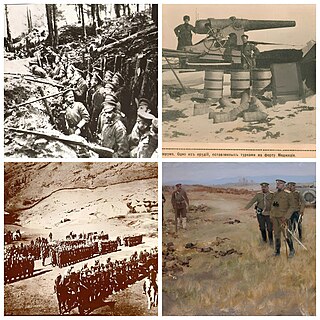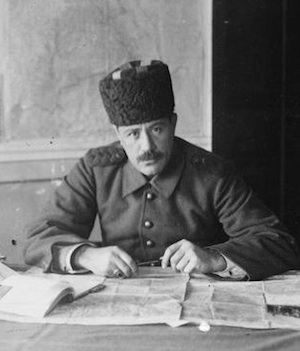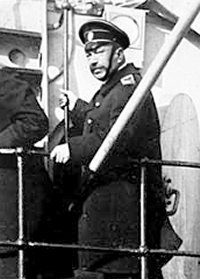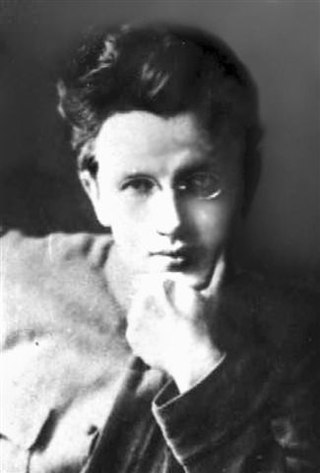Related Research Articles

The Imperial Order of Saint Prince Vladimir was an Imperial Russian order established on 3 October [O.S. 22 September] 1782 by Empress Catherine II in memory of the deeds of Saint Vladimir, the Grand Prince and the Baptizer of the Kievan Rus'.

Nikolai Nikolayevich Yudenich was a commander of the Russian Imperial Army during World War I. He was a leader of the anti-communist White movement in northwestern Russia during the Civil War.

The Erzurum offensive or Battle of Erzurum was a major winter offensive by the Imperial Russian Army on the Caucasus Campaign, during the First World War that led to the capture of the strategic city of Erzurum. The Ottoman forces, in winter quarters, suffered a series of unexpected reverses, which led to a Russian victory.

The Caucasus campaign comprised armed conflicts between the Russian Empire and the Ottoman Empire, later including Armenia, Azerbaijan, Georgia, the Mountainous Republic of the Northern Caucasus, the German Empire, the Central Caspian Dictatorship, and the British Empire, as part of the Middle Eastern theatre during World War I. The Caucasus campaign extended from the South Caucasus to the Armenian Highlands region, reaching as far as Trabzon, Bitlis, Mush and Van. The land warfare was accompanied by naval engagements in the Black Sea.

The Battle of Erzincan was a Russian victory over the Ottoman Empire during the First World War.

The Battle of Bitlis refers to a series of engagements in the summer of 1916 for the town of Bitlis and to a lesser extent nearby Muş, between Russian Imperial forces and their Ottoman counterparts. The town was the last stronghold of the Ottoman Empire preventing the Russians from entering Anatolia and Mesopotamia. Part of the battle is known as Battle of Muş

The Russian Caucasus Army of World War I was the Russian field army that fought in the Caucasus Campaign and Persian Campaign of World War I. It was renowned for inflicting heavy casualties on the opposing forces of the Ottoman Empire, particularly at the Battle of Sarikamish. It was also known for its extremely diverse ethnic composition, consisting of units from throughout the Russian Empire and both soldiers and officers from the many ethnic communities settled since the 1877-78 Russo-Turkish War in the militarily administered Kars Oblast in the Russian Transcaucasus. These included Georgians, Caucasus Greeks, and Armenians - the latter in particular strongly represented among both the soldiers and senior officers - as well as ethnic Russians and Ukrainians.

The Battle of Kara Killisse, also known as the Battle of Malazgirt, was fought on the Caucasus front in July 1915 after the Battle of Manzikert. In Russian historical literature, this engagement is considered as a part of "Alashkert defensive operation". Previously in the summer of 1915 the Russians attacked Turkish positions northeast of lake Van but they underestimated the size of their enemy. They were defeated at the Battle of Manzikert. This success encouraged the Turks under Abdul Kerim Pasha to advance towards the Russians in the Eleşkirt valley while the Turks were pursuing the remnants of Oganovki's army across the Ağrı mountains they spread out and Russian general Yudenich took the opportunity to counterattack from the west with some 20.000 reinforcements, which were mostly Cossack units, to encircle them. in the following battles between 5–8 August the Turks retreated south, but the Russians only partially succeeded. The Turks lost some guns, a large amount of provisions and 10.000 killed and wounded, while 6.000-10,000 became prisoners. Due to difficulties the Russians could not gain total advantage and retreated from the town of Van, and the Turks occupied it on 3 August.

Abdul Kerim Pasha, also known as Abdulkerim Öpelimi, was an Ottoman commander on the Caucasus front of World War I.
Estonian Riflemen, Estonian Red Riflemen, Estonian Red Army, Estonian Red Guards were military formations assembled starting 1917 in the Soviet Russia.
Mishki versus Yudenich is a 1925 Soviet silent comedy film directed by Grigori Kozintsev and Leonid Trauberg. Acting debut of Yanina Zhejmo. The film is believed to be lost.

Mikhail Koronatovich Bakhirev was a Russian naval officer and admiral.

Aleksandr Vladimirovich Razvozov was a Russian and Soviet admiral. He was the first commander of the Soviet Baltic Fleet.

The Russian Orthodox Cemetery, Nice also known as the Orthodox cemetery in Caucade, is a cemetery located southwest of Nice, France.

The Regional (Oblast) Government of Northwest Russia was a short-lived White counter-revolutionary government formed on 10 November 1918, after the October Revolution. Politically, it was a weak, ill-supported, and highly-disorganized governing body, though it formally oversaw the development of the Northern Corps and the antibolshevik operations against Petrograd in autumn 1919.

The Northwestern Army was a White Army that operated in the Pskov Governorate, Saint Petersburg Governorate, Estonia and Latvia during the Russian Civil War from 1919 to 1920.
The 15th Army was a field army of the Red Army during the Russian Civil War and Polish-Soviet War, which existed between 7 June 1919 and 26 December 1920.

The 7th Army was a field army of the Red Army during the Russian Civil War, which existed between November 1918 and February 1920.

Nikolai Gurevich Tolmachyov was a Russian Bolshevik revolutionary and participant of the February and October Revolutions, the Civil War. He was a political worker of the Red Army and one of the first military commissars.

The Russian Army was the armed forces of the White movement, united on an all-Russian scale in 1919 under the sole formal command of the Supreme Commander-in-Chief of all the armed forces of the Russian State Admiral Alexander Kolchak.
References
- ↑ Studies, Royal United Services Institute for Defence (1924). Journal of the Royal United Service Institution.
- ↑ "Yudenich, Nikolaĭ Nikolayevich / 1.1 / encyclopedic". 1914-1918-Online (WW1) Encyclopedia. Retrieved 2025-01-04.